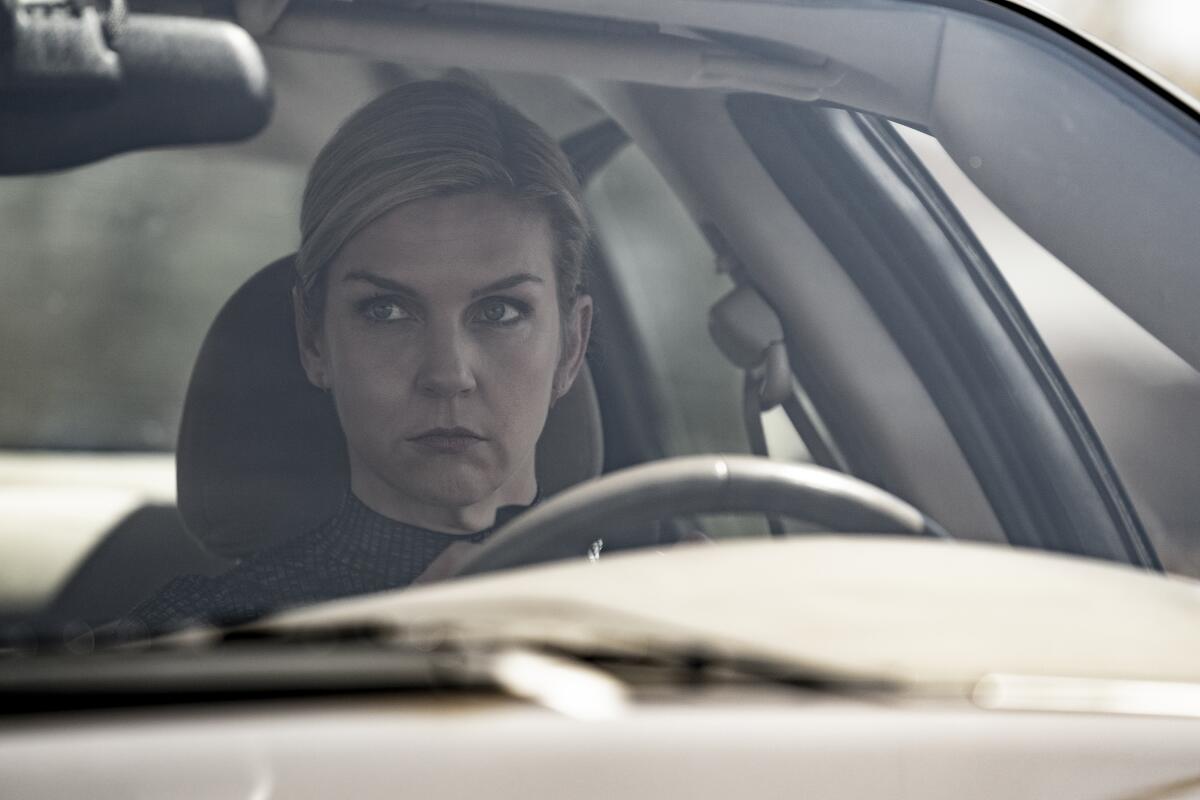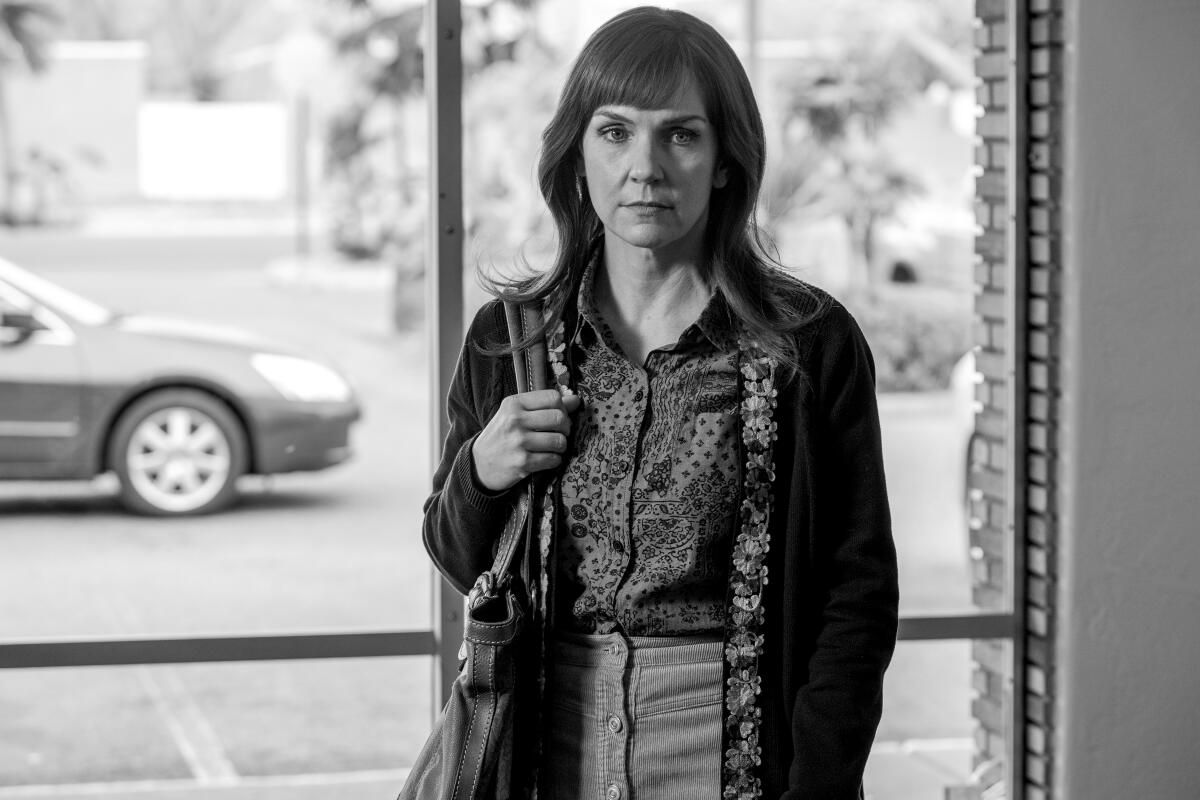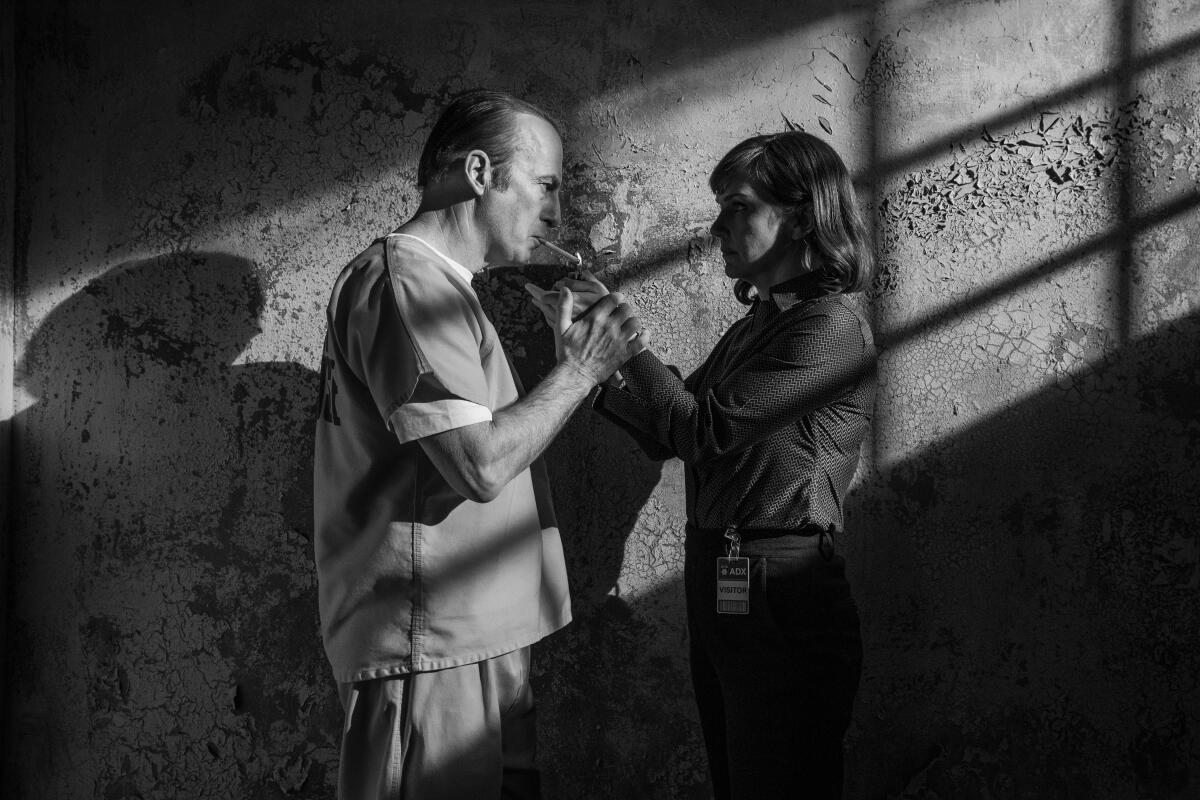
Rhea Seehorn asks, with a thoughtful tone, “Who are you, truly? What does genuine happiness even mean? And what do you actually need to be happy?”
It was a typical Wednesday afternoon, just a short walk from overflowing bookshelves filled with popular titles like John Steinbeck’s “East of Eden” and Sarah J. Maas’s “A Court of Thorns and Roses” series. She started pondering some major life questions while enjoying a vegan brownie and tea at a small table inside Village Well Books & Coffee in Culver City. I was still double-checking the street parking signs, but these weren’t off-the-cuff thoughts – Seehorn had been seriously considering them for months.
When you’re the star of a Vince Gilligan series, facing big, philosophical questions just comes with the territory.
Rhea Seehorn understands complex characters facing inner turmoil. For six seasons on the popular AMC show “Better Call Saul,” a prequel to “Breaking Bad,” she played Kim Wexler, the girlfriend of lawyer Saul Goodman (also known as Jimmy McGill, played by Bob Odenkirk). Kim, a driven and organized lawyer known for her signature ponytail, was initially a moral compass but became increasingly entangled in Jimmy’s schemes and ultimately suffered the consequences of his actions.
With his first project since “Breaking Bad,” Vince Gilligan chose to move away from the familiar formula of a troubled protagonist and instead create a series that truly showcased Rhea Seehorn’s exceptional acting abilities.
Vince Gilligan, co-creator of “Better Call Saul,” noticed something in actress Rhea Seehorn that reminded him of Aaron Paul’s work on “Breaking Bad.” Just like Paul transformed the initially minor character of Jesse Pinkman into a central and captivating figure, Seehorn’s performance elevated her character and made her essential to the story.
According to creator Vince Gilligan, Aaron Paul’s character was essential to the show, and Rhea Seehorn had a similar impact. Gilligan admits he wasn’t familiar with Seehorn before she auditioned, but she was incredible from the start. He and Peter Gould quickly realized she had the potential to elevate the show from focusing on a single character to becoming an ensemble piece. Gilligan knew early on that he wanted to collaborate with her again even after ‘Better Call Saul’ finished.
So he set out to create a story where she was No. 1 on the call sheet.
How did Seehorn process that news?
“I just cried,” she says.
Despite some fans hoping for a show focused on her character, Rhea Seehorn says a Kim Wexler spinoff isn’t currently in the works. However, she’s definitely interested in revisiting the role in any capacity – whether it’s a series, a movie, or even a commercial!

Apple TV’s new show, “Pluribus,” has been kept under wraps, with very few details released beforehand. Here’s what we know: Rhea Seehorn stars as Carol, a successful romance author who is secretly deeply unhappy, despite appearing to have a perfect life. When a mysterious signal from space dramatically alters the world, Carol is tasked with saving humanity… from happiness. The nine-part series launches with two episodes on November 7th, followed by weekly releases.
For a while, Seehorn only had the first script to make her assessments about the world Gilligan was building. She eventually got her hands on two more before 2023’s dual Hollywood strikes kicked in. When she finished reading through them, one thought came to mind: “‘Wow, this is a lot of me,’” she says, launching into laughter. “He had warned me — ‘You’re going to be in almost every scene’ — but then you read it and you’re like, ‘Oh … oh.’”
She deliberately avoids revealing details, saying, “I can’t say too much. I spend a lot of time working alone, and I don’t want to give anything away!” Despite needing to be secretive about the show, she’s genuinely open and excited when talking about how much the experience meant to her as an actress.
She explained that ‘Better Call Saul’ benefited from being connected to ‘Breaking Bad,’ but this new project felt different. Vince Gilligan, the creator, wanted to truly challenge expectations – to create something that didn’t fit neatly into any one genre or maintain a consistent tone. It’s a show that can be both very funny and deeply disturbing, and it’s genuinely frightening in many ways. Ultimately, it forces you to consider how you would react if you were in a similar situation.
Wanting to reflect the show’s themes of happiness and what it means to be human, I asked Rhea Seehorn to choose a place she enjoys for our meeting, which brought us to a bookstore near her house. She admits she’s a constant book buyer, recently picking up Rachel Kushner’s “Creation Lake.” However, she’s currently focused on “Eleven Days in Hell” by William T. Harper, a true story about a prison standoff in Texas. At the time we spoke, Seehorn was just days away from starting filming on a movie adaptation of the book, co-starring Taylor Kitsch and Diego Luna.
She gets really excited when the conversation turns to what she likes to watch for fun during filming of “Pluribus.” “I’m totally addicted to ‘Chicken Shop Date,’” she exclaims. “Have you seen it? I’m serious – can we use this article to try and get me on the show? I’m making it my mission!”

I finished up work on “Pluribus” last December, and since then, things have been a bit of a whirlwind! I managed to shoot an indie film called “Sender” with Britt Lower – she’s fantastic, you might know her from “Severance” – and squeezed in a quick family vacation. On top of that, we helped my oldest stepson get ready for college. It’s funny, those everyday life moments, those big feelings… they really inform the kinds of questions the show I’m working on explores, and what it’s all about, you know?
Seehorn describes the show as a deep dive into self-discovery and how we cope with challenging feelings. She explains it explores a universal sense of anxiety, like having a nightmare where you’re desperately trying to warn people about a danger they refuse to acknowledge.
She adds, “It’s natural to wonder how you define success – in all areas of life, like relationships, your career, your skills, and what you want to achieve.” We often build defenses, either for the long haul or just to get through tough times. Sometimes, the things we do to cope or protect ourselves are helpful at first, but eventually become unnecessary or even hold us back. The actress Carol’s initial struggles – feeling unhappy and doubting those who appreciated her work because she didn’t think it was good enough – was something the director and I discussed at length, as people working in creative fields.”
Kimiko Glenn, who used to go by Debbie, didn’t spend much time thinking about life’s big questions as a child. Born in Norfolk, Virginia, she moved around a lot during her childhood, living in places like Arizona and Japan due to her father’s work with the Naval Investigative Service – which later became known as NCIS. She playfully points out her father wasn’t like the famous TV agent, Mark Harmon. After her parents divorced when she was twelve, she and her family settled in the Virginia Beach area.
Rhea Seehorn didn’t seem destined for an acting career, but creativity ran in her family. Her mother was involved in musical theater, and both her father and grandmother were painters. Rhea and her sister started drawing very young. She originally planned to work in design or art, even studying painting at George Mason University, and imagined a career at a museum like the Smithsonian. However, an introductory college course gave her a chance to explore acting, something she hadn’t seriously considered before.
Growing up, I noticed that American TV and movies mostly featured very polished, model-like people. I didn’t fit that image, and I was afraid I’d be ridiculed if I ever said I wanted to be an actor. It felt as unrealistic as trying to become a supermodel. But as soon as I started my first acting class, I knew I’d found what I was meant to do.
Lynnie Raybuck, a teacher and actor who continues to inspire Seehorn, led the class. It’s here—both in life and as we talk—that Seehorn’s passion for acting really shines through. She becomes very enthusiastic when discussing Practical Aesthetics, a technique created by David Mamet and William H. Macy for the Atlantic Theater Company, and explains how much she enjoys carefully analyzing scripts.
I was shocked when I realized some people aren’t just naturally gifted – they’ve developed their talent through hard work. The idea that you could actually learn to improve and connect with an audience, to truly captivate them and make a performance believable, was incredibly exciting. That’s when I knew what I wanted to do with my career.



Rhea Seehorn played the role of Kim Wexler, alongside Bob Odenkirk as Saul Goodman (also known as Jimmy McGill), in the television series “Better Call Saul.” (Photo: Greg Lewis/AMC/Sony Pictures Television)
She understood that acting wouldn’t bring in money immediately. She took on various jobs to make ends meet – ushering, selling tickets, and even reading scripts for upcoming plays. She also worked regular jobs, like at TGI Fridays, where they eventually gave her a hostess uniform with suspenders because she wasn’t old enough to serve drinks. At Fridays, she’d help waiters by assembling orders at the expo station.
She eventually moved to New York City and began working at Playwright Horizons, a theater known for its off-Broadway productions. After a few years, she decided to move to Los Angeles and landed a role on the ABC sitcom “I’m With Her,” which starred Teri Polo and was inspired by the marriage of writer Chris Henchy and Brooke Shields. Although the show didn’t last long, she continued to find work in television. She had a recurring part as an assistant district attorney on the legal comedy-drama “Franklin & Bash” and played the best friend of Whitney Cummings’ character on NBC’s “Whitney,” which aired for two seasons between 2011 and 2013.
When “Better Call Saul” was being developed, the casting team already knew Rhea Seehorn well. She had auditioned for them several times over the years, so they were aware of her talent and what she could bring to a role.
I first met Rhea during auditions for the show. There were three actresses reading for the role of Kim, and while the other two were both really talented, Rhea and I immediately clicked. There was a clear connection between us – everyone felt it, and it made working together effortless, says Odenkirk.
She was chosen to play Kim before the character even had a last name, and no one realized how important she would become to the plot. It soon becomes apparent how thoroughly she analyzes her roles. Both Bob Odenkirk and Vince Gilligan independently mentioned that her scripts were frequently covered in handwritten notes, highlights, and sticky tabs.
Seehorn recalls having very little dialogue in the first episode – just one line besides what came through the intercom, which she still remembers. She later learned it wasn’t intentional that her character rarely used contractions like ‘wanna’ or ‘don’t’ while others did. She considered asking if it was okay to use those more casual forms, but then decided to focus on understanding how this character spoke. This led her to explore the character’s reserved nature, questioning why she would speak so formally. Seehorn became deeply invested in the character, building her personality through subtle cues and a hidden inner life that she felt the audience was uniquely privy to.


Rhea Seehorn worried people would laugh at her if she said she wanted to be an actress, comparing it to aspiring to be a supermodel. However, she knew instantly, after taking just one acting class, that it was her true calling. (Anthony Avellano/For The Times)
Odenkirk praises Seehorn’s dedication and how they both worked to ensure their characters felt emotionally believable. He points out a challenge the “Better Call Saul” writers often faced: creating dramatic tension between Jimmy and Kim, who understood each other so well, typically required situations where characters would be less aware or more naive.
He explains that Kim and Jimmy’s relationship included instances of dishonesty – not frequently, but enough to create tension. They constantly had to navigate these lies, with one always aware the other wasn’t being truthful. Sometimes, they’d find a workaround, and other times, Rhea Seehorn’s character, Kim, would skillfully let it go. He admires her dedication and her ability to become fully immersed in their shared ambitions.
It’s why he’s not surprised Gilligan wanted her to lead his next series.
Odenkirk describes her as a powerful performer. He highlights her impressive strength and versatility on screen, noting she possesses the same strong, determined qualities you’d expect from a leading actor.
Actually, when Gilligan first started developing the idea for “Pluribus” while working on “Better Call Saul,” he originally pictured a male lead character.
“But I would take these long walks during our lunch breaks in the writers room and, I can’t remember when exactly, but it dawned on me on one of those walks that I really like this young lady, Rhea Seehorn,” he says. “She’s a really good actor. And I started thinking, ‘Why does the main character of my next show have to be a guy? ‘ I was about to say I kind of tailored the role to Rhea, but the truth is, I don’t know if that’s true. Rhea has so many strengths as an actor, I know she can do anything I threw at her — just like I knew many years before that Bryan Cranston could do anything. She makes it look easy.”
A few weeks after we first met, I spoke with Seehorn over video call. She was on a break from filming “Eleven Days” and calling from a plain room. Since our last conversation, she’d been doing jigsaw and paint-by-number puzzles – things she does to relax and switch off her acting mind – and showed me a finished plant painting. We started talking about what makes her happy at this moment.
I’ve been thinking about her a lot, and it’s clear her life is built around the things that matter most – her loved ones and her career. She seems to have it all, really – the kind of success many of us dream of, especially in a creative field. But it’s heartbreaking to see that she can’t fully accept it. It’s like she preemptively puts down her work and even the people who admire it, almost as if she’s trying to tear herself down before anyone else can. It feels like a deep self-hatred, a way of bracing for criticism by being critical of herself first.
She explained that she’s completely comfortable with work being a key source of her happiness, alongside her family. It’s a core part of who she is, and pursuing her passion actually makes her a better stepmother and partner.
She’s also expanding her work behind the camera. She’s now an executive producer on the Swiss TV show “$hare” and recently directed an episode of “Better Call Saul.” She’s eager to direct more, currently discussing potential projects. When asked why she didn’t direct earlier, like in the first season of “Pluribus,” she joked that she was simply overwhelmed just trying to manage everything.
She mentioned the children’s book “Archibald’s Next Big Thing” by actor Tony Hale, a former co-star from her time on “Veep.” The book is all about learning to enjoy the process, not just the outcome.
She felt he kept changing the requirements, which was self-sabotaging and prevented him from appreciating his current situation. She also observed that Carol only realized the value of things after they were gone, and that she could have been happier if she’d stopped being so critical of both others and herself.
Her performance served as a powerful reminder to think creatively and challenge expectations. The first episode is incredibly complex, featuring a 12-minute sequence where her character navigates a whirlwind of emotions – confusion, fear, grief, anger, and frustration – feeling both isolated and connected at the same time.
I was immediately anxious about playing Carol,” she explains. “When Vince sent me the script, I thought it was completely wild. I even had moments driving to set where I considered just turning around and running away. But I knew I had to give it my all. I definitely filmed some awkward takes, but I kept telling myself, ‘When will I ever get a chance like this again? Now is the time to try.’
In other words, she says, “Don’t be a Carol.”
Read More
- Mobile Legends: Bang Bang (MLBB) Sora Guide: Best Build, Emblem and Gameplay Tips
- Brawl Stars December 2025 Brawl Talk: Two New Brawlers, Buffie, Vault, New Skins, Game Modes, and more
- Clash Royale Best Boss Bandit Champion decks
- Best Hero Card Decks in Clash Royale
- Call of Duty Mobile: DMZ Recon Guide: Overview, How to Play, Progression, and more
- Clash Royale December 2025: Events, Challenges, Tournaments, and Rewards
- Best Arena 9 Decks in Clast Royale
- Clash Royale Best Arena 14 Decks
- Clash Royale Witch Evolution best decks guide
- Brawl Stars December 2025 Brawl Talk: Two New Brawlers, Buffie, Vault, New Skins, Game Modes, and more
2025-10-29 13:33